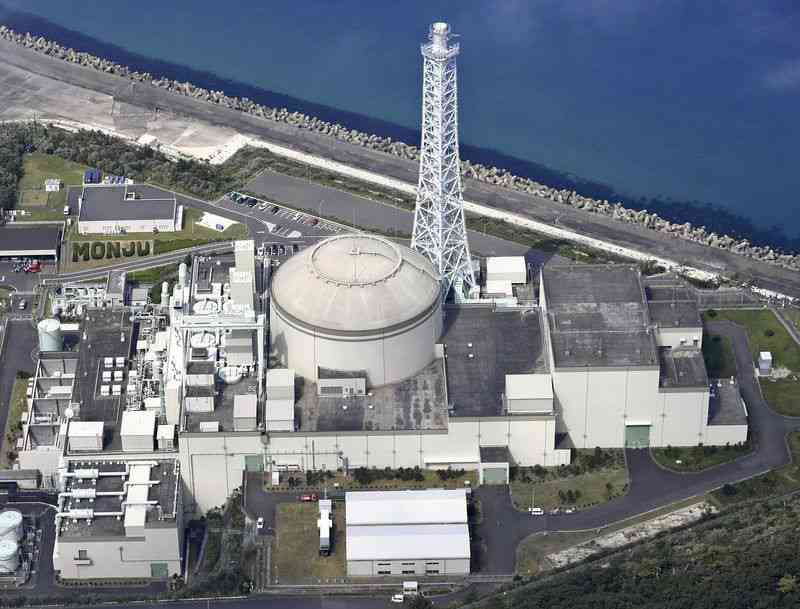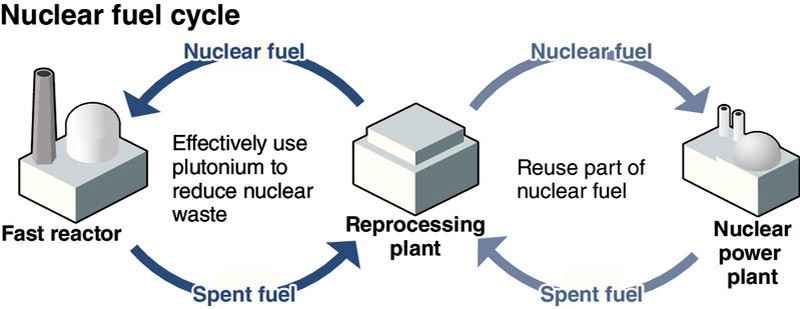
The site of the former Monju reactor is seen in Tsuruga, Fukui Prefecture.
16:16 JST, January 2, 2022
WASHINGTON — Japan will participate in a U.S. project to develop a next-generation fast reactor, The Yomiuri Shimbun has learned from sources in Japan and the United States.
The Japan Atomic Energy Agency and Mitsubishi Heavy Industries, Ltd. will provide technical cooperation to the project led by U.S. nuclear start-up TerraPower, LLC, founded by Microsoft Corp. cofounder Bill Gates, and the U.S. Energy Department.
The Japanese side will also allow safety tests to be conducted at a facility in Japan.
The parties are to sign a cooperation agreement as early as this month and aim to start operation of the reactor in Wyoming in 2028.
Fast reactors are nuclear reactors that utilize the characteristics of high-speed neutrons to burn plutonium and other fuels more efficiently than conventional nuclear power plants, which are predominantly light-water reactors. Fast reactors can reduce the amount of radioactive waste that emits intense radiation for a long period of time.

For Japan’s nuclear fuel cycle policy, which aims to extract plutonium from spent nuclear fuel for reuse, fast reactors are indispensable. However, there is no feasible plan for commercial use of such reactors ever since the decision to decommission the Monju fast breeder reactor in Fukui Prefecture in 2016. Monju had experienced a succession of technical troubles.
By participating in the U.S. project, the Japanese side aims to acquire technologies necessary to build better fast reactors in Japan.
TerraPower and the U.S. Energy Department plan to build a fast reactor with an output of 345 megawatts in Kemmerer, Wyo., and each will contribute half of the $4 billion (about ¥450 billion) construction cost.
The reactor will be cooled using liquid sodium. Sodium is difficult to handle as it is intensely reactive when coming into contact with water or air. It can, however, efficiently remove heat from a nuclear reactor.
The new reactor will use longer-lasting fuel with a higher concentration of uranium than light-water reactors, greatly increasing its economic efficiency as a next-generation reactor.
The United States, however, has kept away from full-scale fast reactor development since the 1970s, so has little achievements in the field. Therefore, it has been approaching Japan for technical cooperation as the nation has accumulated rich experience with the Monju fast breeder reactor and the Joyo experimental fast reactor in Ibaraki Prefecture, which are both sodium-cooled.
The Japanese side will provide design technology and operational data. Safety tests necessary for the new design will be conducted at AtheNa, a large test facility for sodium experiments in Ibaraki Prefecture. The Economy, Trade and Industry Ministry and the Education, Culture, Sports, Science and Technology Ministry, which both have jurisdiction over the JAEA, will support the preparation of the facility.
A liquid sodium leak at the Monju reactor in 1995 caused a fire, but a senior industry ministry official said, “The United States wants Japan’s experience, including its failures.”
The administration of the U.S. President Joe Biden, which has made the fight against global warming one of its key policies, is aiming to establish a leading position in the nuclear power market by hastening the development of fast reactors while utilizing the technology accumulated by Japan. According to the U.S. Nuclear Energy Institute, the size of the market in 2050 will be ¥40 trillion, about four times the size in 2020. Of that amount, next-generation reactors will account for ¥10 trillion.
Fast reactors are promising, and China and Russia are leading the way with plans to enter commercial operation in the 2030s.
Chris Levesque, president and CEO of TerraPower, acknowledged that the company is in talks with the Japanese side in an interview with The Yomiuri Shimbun.
He expressed hopes that the Japanese side will share its experience in fast reactor development and allow the U.S. side to utilize “excellent testing facilities in Japan.”
Levesque added, “I really see a strong opportunity for Japanese-U.S. cooperation.”
"Science & Nature" POPULAR ARTICLE
-

Genome Study Reveals Milestone in History of Cat Domestication
-

Big Leap in Quest to Get to Bottom of Climate Ice Mystery
-

Japan Set to Participate in EU’s R&D Framework, Aims to Boost Cooperation in Tech, Energy
-

Paws on Parade: Nairobi’s Dogs Dazzle at ‘Pawchella’
-

Japan’s H3 Rocket Failed in Latest Launch, Says Official
JN ACCESS RANKING
-

Tokyo Economic Security Forum to Hold Inaugural Meeting Amid Tense Global Environment
-

Keidanren Chairman Yoshinobu Tsutsui Visits Kashiwazaki-Kariwa Nuclear Power Plant; Inspects New Emergency Safety System
-

Imports of Rare Earths from China Facing Delays, May Be Caused by Deterioration of Japan-China Relations
-

University of Tokyo Professor Discusses Japanese Economic Security in Interview Ahead of Forum
-

Japan Pulls out of Vietnam Nuclear Project, Complicating Hanoi’s Power Plans






















